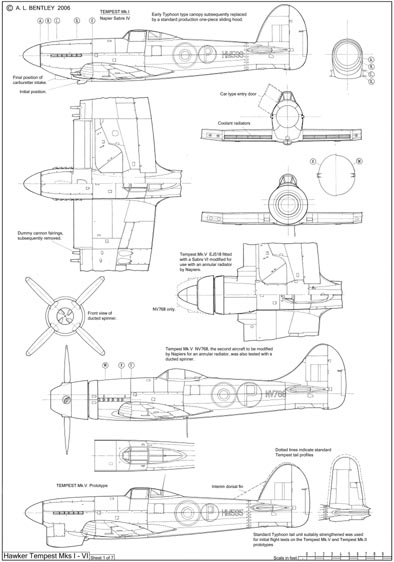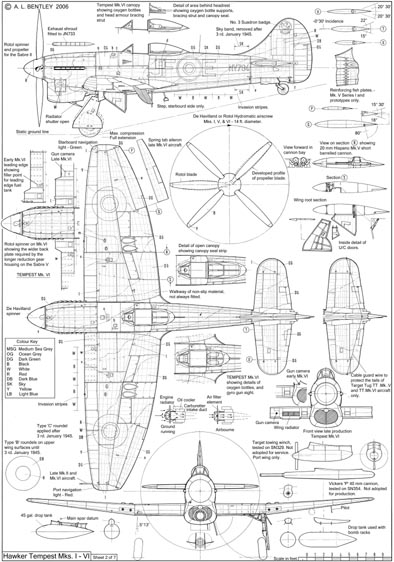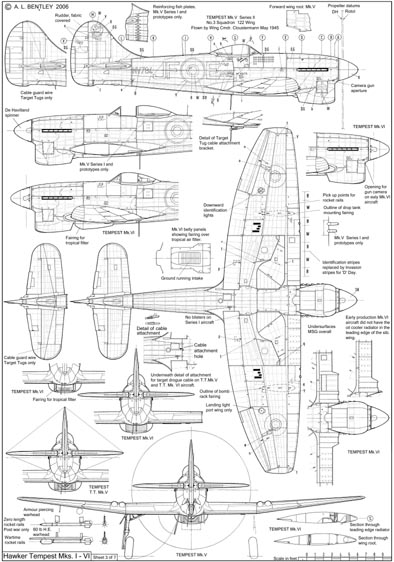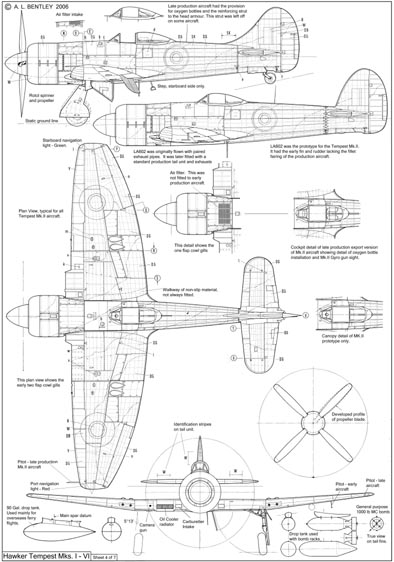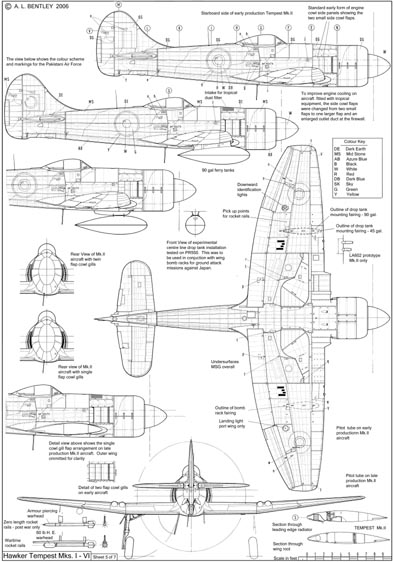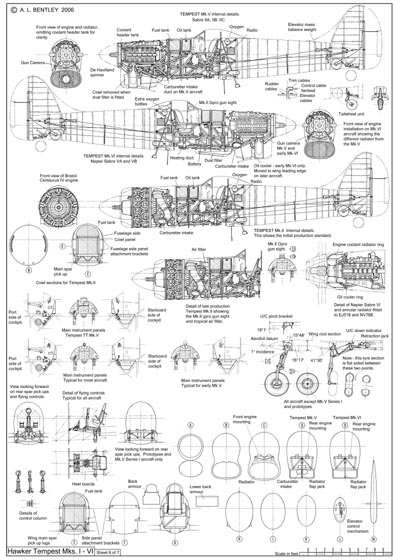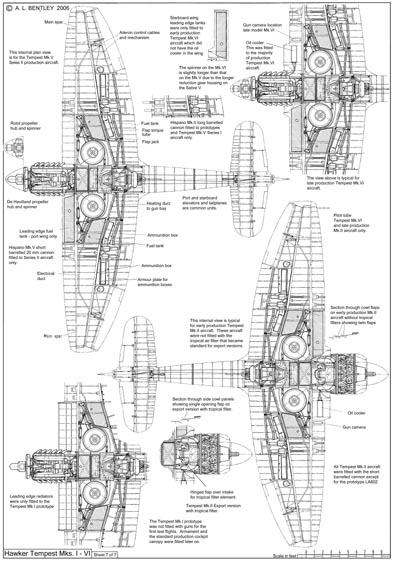The Hawker Tempest was a British fighter aircraft primarily used by the Royal Air Force (RAF) in the Second World War. The Tempest was an improved derivative of the Hawker Typhoon, and one of the most powerful fighter aircraft used during the war.
During development of the Typhoon the design team, under the leadership of Sydney Camm, were already planning design improvements, this process resulting in the Hawker P. 1012 (or Typhoon II). Although the Typhoon was basically a good design, Camm and his design team were disappointed with the wing which proved to be too thick in its cross section; this created airflow problems and inhibited flight performance, especially at higher altitudes. The Typhoon’s wing, using a NACA 4 digit series wing section, had a maximum thickness to chord ratio of 19.5% (root) to 12% (tip). In March 1940, engineers were assigned to investigate the new low drag laminar flow wing developed by NACA in the United States, which had been used in the new North American P-51 Mustang. A laminar flow wing adopted for the Tempest series had a maximum thickness to chord ratio of 14.5% at the root, tapering to 10% at the tip. The maximum thickness of the Tempest wing was set further back at 37.5% of the chord versus 30% for the Typhoon’s wing.
The wingspan was originally greater than that of the Typhoon at 43 ft (13.1 m), but the wing tips were later “clipped” and the wing became shorter; 41 ft (12.5 m) versus 41 ft 7 in (12.7 m). The wing planform was changed to an elliptical shape to accommodate the 800 rounds of ammunition for the four 20 mm (.79 in) Hispano cannons, which were moved back further into the wing. The new elliptical wing had greater area than the Typhoon’s. However, the new wing design sacrificed the leading edge fuel tanks of the Typhoon: to make up for this loss in capacity, Hawker engineers added a new 21 in (53 cm) fuel bay in front of the cockpit, with a 76 gal (345 l) fuel tank. In addition, two inter-spar wing tanks, each of 28 gal (127 l), were fitted on either side of the centre-section and, starting with late model Tempest Vs, a 30 gal (136 l) tank was carried in the leading edge of the port wing root, giving the Tempest a total internal fuel capacity of 162 gal (736 l).
In service, Tempests also carried two specially designed, streamlined, drop tanks of 45 gal (204 l) giving a maximum of 360 gal (1,636 l) and an operational radius of 500 mi (805 km) Another important feature of the new wing was Camm’s proposal that radiators for the new Napier Sabre IV engine were to be fitted into the leading edge of the wing inboard of the undercarriage. This eliminated the distinctive “chin” radiator associated with the Typhoon and improved aerodynamics. A further improvement of the Tempest wing over that of the Typhoon was the exceptional, flush riveted surface finish, essential on a high performance laminar flow air foil. Fortunately for the pilots, the new wing and air foil, and the four-bladed propeller unit, eliminated the high frequency vibrations that had plagued the Typhoon.
The redesigned main undercarriage legs were longer and had a wider track (16 ft/5 m) to improve stability at the high landing speed of 110 mph (180 km/h), and to allow tip clearance for a new de Havilland 14 ft (4 m) diameter four-blade propeller. The main undercarriage units were Dowty levered suspension units incorporating trunnions which shortened the legs as they retracted. The majority of the Tempests built used 30 by 9 inch (76.2 by 22.9 cm) four-spoke wheels, while the prototypes and early production Tempest Vs used the Typhoon’s larger 34 by 11 inch (83.4 by 28 cm) five-spoke wheels. The retractable tail-wheel was fully enclosed by small doors and could be fitted with either a plain Dunlop manufactured tyre, or a Dunlop-Marstrand “twin-contact” anti-shimmy tyre.
Camm and the Hawker design team placed a high priority on making their aircraft easily accessible to both air and ground crews; to this end the forward fuselage and cockpit areas of the earlier Hurricane and the Tempest and Typhoon families were covered by large removable panels providing access to as many components as possible, including flight controls and engine accessories. Both upper wing roots incorporated panels of non-slip coating. For the pilot a retractable foot stirrup under the starboard root trailing edge was linked to a pair of handholds which were covered by spring-loaded flaps. Through a system of linkages, when the canopy was open the stirrup was lowered and the flaps opened, providing easy access to the cockpit. As the canopy was closed the stirrup was raised into the fuselage and the flaps snapped shut.
Other Variants
Typhoon Mk II : The original designation of the Hawker Tempest.
Tempest Mk I : Prototype fitted with the Napier Sabre IV piston engine with oil coolers and radiators placed in the wing to reduce drag, one aircraft.
Tempest Mk III : Prototype fitted with the Rolls-Royce Griffon piston engine.
Tempest Mk IV : Tempest Mk III prototype re-engined with a Rolls-Royce Griffon 61 piston engine.
Tempest Mk V : Single-seat fighter, fighter-bomber aircraft, powered by the Napier Sabre II piston engine, 801 built at Langley.
Early series Tempest Mk V : The first 100 production aircraft were fitted with four long-barrel 20 mm (.79 in) Mark II Hispano cannons and continued to use some Typhoon components.
Mid to late series Tempest Mk V : The other 701 production aircraft were fitted with four short-barrel 20 mm Mark V Hispano cannons and other production line changes.
Tempest TT Mk 5 : After the Second World War a number of Tempest Mk Vs were converted into target tugs.
Tempest F Mk II : Single-seat fighter aircraft for the RAF, powered by a Bristol Centaurus radial piston engine, 402 built by Hawker at Langley and 50 by Bristol Aeroplane Company, Banwell.
Tempest FB Mk II : Single-seat fighter-bomber with underwing pylons for bombs and rockets.
Tempest F Mk VI : Single-seat fighter aircraft for the RAF engined with the Sabre V (2,340 hp), 142 built.

